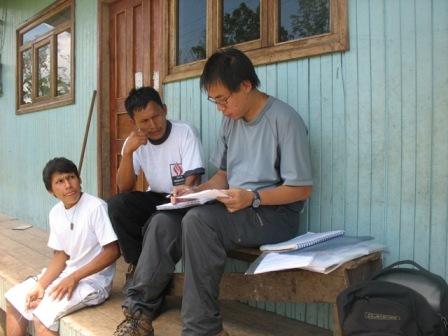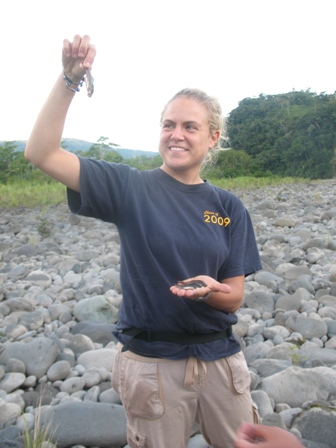Current Projects:
The Shuar Health and Life History Project
Human Universals Project
Evolution of Human Attractiveness
Cognitive
Cultural Studies Project
Shuar Health and Life History Project
In 2005, I established the Shuar Life History Project in Southeastern Ecuador to investigate the evolution of life history tradeoffs, and their effects on health in this population undergoing rapid cultural change. In 2007 Josh Snodgrass came on board and added a significant bio-marker component to the project. Josh and I now co-direct the project with Josh taking primary responsibility for lab analysis and while I have primary responsibility for directing fieldwork and data collection. See photo gallery for team members in action. For more information regarding research team members, click here.
The SHLHP examines the effects of increasing market integration (MI) on life history tradeoffs and health among indigenous Shuar and non-Shuar colonists (colonos) of the trans-Cutucu region of Amazonian Ecuador. Traditionally forager-horticulturalists, Shuar currently experience a wide range of market integration (MI) across their territory. This provides an important opportunity for addressing how economic, social, and dietary changes associated with MI affect life history tradeoffs, and how those tradeoffs affect health. It allows examination of particular aspects of MI, predicted life history changes, and actual behavior and health across a wide range of conditions within the same ethnic group. Simultaneously, comparison of Upano Valley Shuar with their colono neighbors provides an opportunity to examine these same variables among people from a different cultural background living under the same socio-ecological conditions.
SHLHP research has four basic objectives:
1) to determine the effects of MI on diet, activity, social relations and health among indigenous Shuar and non-Shuar colonos of Morona Santiago and Zamora, Ecuador
2) to test hypotheses about life history tradeoffs between growth, reproduction, immune function, parental investment, and allo-parental investment, and their health related consequences
3) to test hypotheses derived from theories regarding the evolution of human life history, including the embodied capital, grandmother, and cooperative breeding hypotheses
4) to provide participants and
collegues with useful health,
economic, and social data useful for planning
and carrying out health programs in the study area.
More broadly, it
seeks to further understanding of how natural selection shaped the
age-related relationships between important life history variables in
humans, and how these are related to health outcomes. From a
humanitarian standpoint, it seeks to understand the causes and
consequences of differing health outcomes to help target local
education and treatment programs toward amelioration of the most
important causes of mortality, morbidity, and poor health outcomes.
Support for the project has come from: The Center for Evolutionary Psychology via an NIH Award to Leda Cosmides; NSF (Physical Anthropology); the Wenner-Gren Foundation; The Leakey Foundation; the University of Oregon Institute for Cognitive and Decision Sciences; the Sasakawa Fund and; the Evonuk Foundation.
For more information regarding the project, click here.
Human Universals Project
The Human Universals Project seeks to facilitate the cross-cultural testing of hypotheses about human neuro-cognitive adaptations, hypothesized to characterize the functional aspects of the human mind. Established by John Tooby and Leda Cosmides at the Center for Evolutionary Psychology, I established the Ecuadorian Oriente Research Station in 1994, and currently serve as Co-Director of Field studies at the site.
We have been adapting and carrying out a variety of cross-cultural experiments, to investigate hypothesized cognitive and emotional adaptations, predicted to be universal to our species.
To date, the project has tested or is developing studies about reasoning or emotional systems regarding: social exchange; threat; precaution; collective action; foraging and social memory; predator-prey specializations; the computational architecture of anger; spatial cognition; mother-infant communication; status perception and its relationship to aggressive formidability; risk of injury and its relationship to cooperation and; perceived attractiveness. Current studies I am working on include:
Attractiveness assessment (w/Melissa Liebert, Julian Lim, Ian Penton Voak, Steve Josephson)
Kin Recognition Mechanisms (w/Melissa Liebert, Aaron Blackwell, John Tooby, Leda Cosmides)
Object memory and foraging cognition (w/Max Krasnow, Aaron Blackwell, Melissa Liebert, Leda Cosmides, John Tooby)
The evolved computational architecture of motivational adaptations for regulating the concern of others in ones own welfare (w/Julian Lim, Leda Cosmides, John Tooby)
Anger and conflict management
(w/Julian Lim, Aaron Sell, John
Tooby, Leda Cosmides)
Adaptations underlying
patterns
of social aid (w/Tess Robertson,
Leda Cosmides, John Tooby)
Evolution of Human Attractiveness
I have argued that human physical attractiveness assessment is generated by adaptations functioning to evaluate evolutionarily relevant cues to human social value across multiple domains of interaction (e.g., kin, mating, cooperation). And, that evolutionary human life history theory and data from small-scale foraging societies are instrumental in generating predictions about these domains of social value and the cues associated with them.
In a 2005 chapter for David Buss' Handbook of Evolutionary Psychology, I laid out these arguments and a number of predictions about human attractiveness assessment which had yet to be tested. The Evolution of Human Attractiveness Project is designed to experimentally test a select group of these hypotheses, as test cases for this view of the evolution of human attractiveness assessment psychology. To that end, my collegues and I have been carrying out studies both with undergraduates in the lab, and among indigenous Amazonian populations. Studies currently underway or being written up for publication include:
Evolution of body shape preference (with Aaron D. Blackwell)
Does Facial Symmetry Predict Phenotypic Quality and Attractiveness?
(w/Steve Frost)
Demography and the Evolution of Facial Attractiveness (w/Ian Penton Voak, Steve Josephson, Melissa Liebert)
Development, 2d/4d, Fluctuating Asymettry, and Attractiveness (w/Deana Morris, Steve Frost, Robert Pastor, Josh Snodgrass, Frances White)
Health cues, attractiveness,
reproductive value and mating behavior (w/Aaron Blackwell)
Cognitive
Cultural
Studies
Project
(CCSP)
Michelle Scalise
Sugiyama and I are extending her groundbreaking work on the evolved
psychology underlying narrative to examine the cognitive adaptations
underlying several pathways of cultural
production and transmission. This work is helping us to better
understand cultural
similarity and differences, as well as the evolution of human life
history.
The goal of the CCSP is
twofold: to understand pan-human cultural
phenomena in terms of their evolved cognitive scaffolding, and to use
pan-human cultural phenomena to illuminate design features of the mind
and the selection pressures that produced them. CCSP research
emphasizes comparative study of cultural transmission in traditional,
small-scale societies.
Research foci include folklore and mythology, visual and plastic arts, decorative arts, dance, music, religion/ritual, games/play, and evolutionary aesthetics. These behaviors are examined in the context of adaptive problems related to subsistence, mate selection, child care, predator avoidance, cognitive mapping, cooperation, warfare, etc., and are also studied in relation to distinguishing characteristics of our species, such as social learning, pretense, theory of mind, and the evolution of prolonged juvenility. The overarching goal of the CCSP is to advance an integrated picture of the role these behaviors play in foraging societies and, by extension, the role they played in ancestral human environments.
Bringing to bear both archival and field research, we are engaged in three basic projects:The Forager Folklore Sample (FFS)
Successful exploitation of the foraging niche requires extensive, specialized knowledge, much of which is acquired through social learning. Research indicates that the oral tradition serves as a vector for information relevant to many recurrent problems of forager existence. The aim of this project is to develop and deploy a random stratified sample of forager folklore collections to test hypotheses regarding the kinds of information humans are designed to acquire through social learning.
Character, Narrative and the Mind
Character is a fundamental component of narrative: stories are about human beings (or agents with a human psychology). Thus, narrative is a behavior involving the generation of representations of the human mind. It follows that narrative comprehension and production require theory of mind--the ability to attribute mental states to conspecifics and to understand behavior in terms of mental states. Mindreading is not reducible to one capacity; it is best envisioned as a suite of integrated mechanisms, each of which has its own developmental onset. This project examines narratives elicited from preschool and grade-school children to better elucidate the tasks involved and mechanisms enlisted in mapping and navigating the social world.
Pathways of Cultural Transmission
Humans have a distinctive
constellation of mental, social, and life
history traits that undelie modern behavior and our reliance on
cooperation and cumulative
culture. This project documents and analyzes patterns in the
transmission
of important daily life skills among Shuar foragers vis-a-vis the
cooperative breeding hypothesis for human childrearing. Collegues with
fieldsites in other areas of the world who are
interested in collaborating in the collection of cross-cultural data on
this topic are invited to contact us.
For more information on the
CCSP, click
here.


























